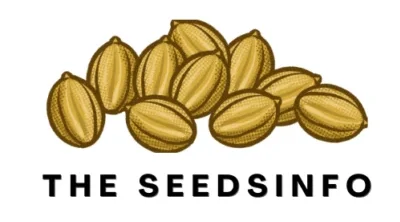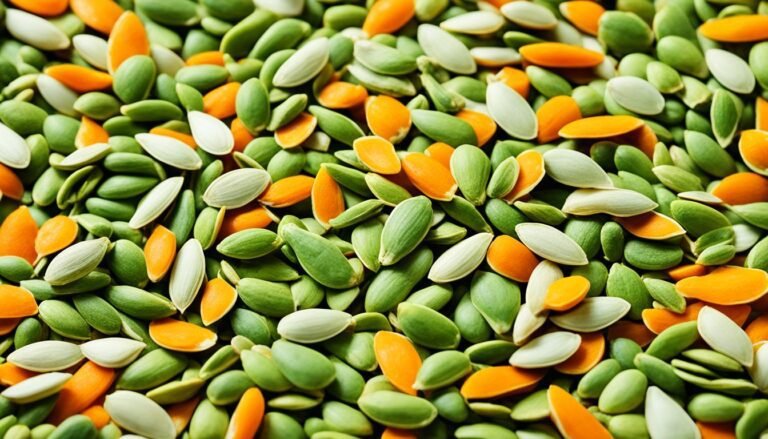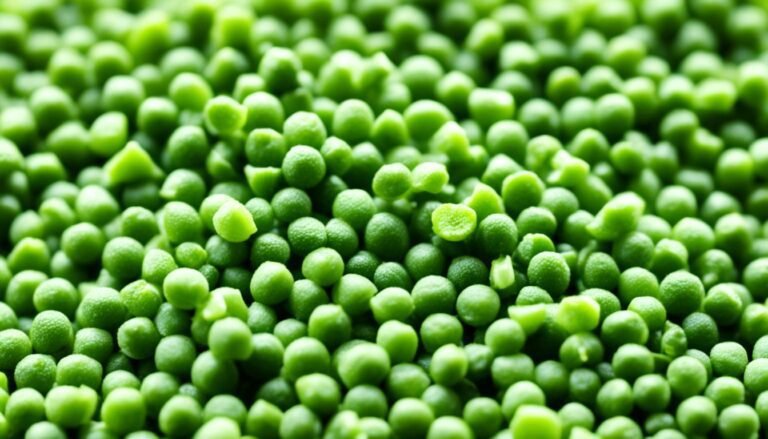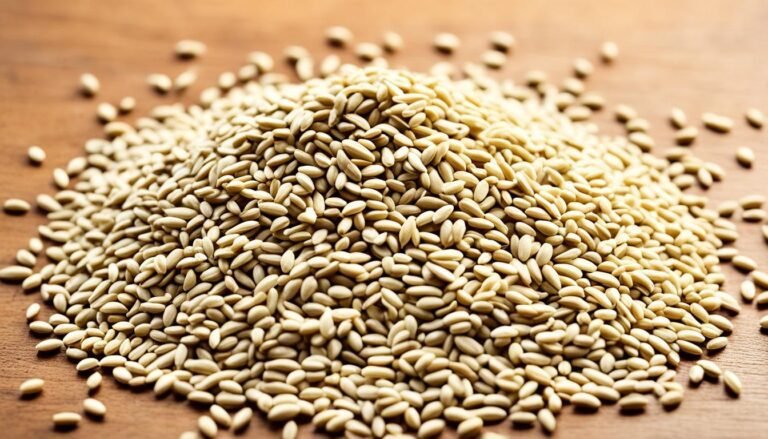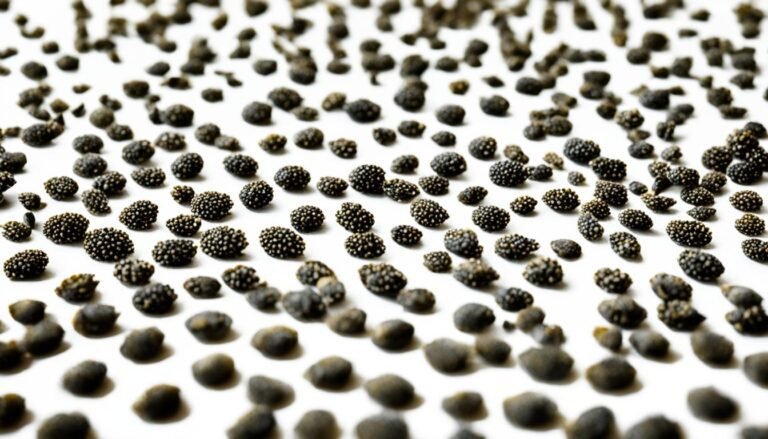Discover the Magic of Mustard Seeds in Your Kitchen

Mustard seeds are small but mighty. They come in many sizes, colors, and tastes. Black types are sharp, while yellow and brown are milder. These seeds are found in kitchens everywhere. They add a special kick to dishes. For instance, they can make veggies more interesting. They can also give seafood a spicy edge. And let’s not forget homemade sauces.
This article will show you why mustard seeds matter. We’ll talk about their different types and uses. Plus, we’ll cover their health benefits. You’re about to learn how these tiny seeds can liven up your meals.
Introduction to Mustard Seeds
Mustard seeds are small and packed with flavor. They come from plants in the Brassica family. These seeds have a rich history, loved for taste and their health benefits. They are a key ingredient in the kitchen and in medicine.
Culinary and Medicinal Significance of Mustard Seeds
In cooking, mustard seeds bring out rich flavors in dishes. They have a bold, slightly spicy taste. You’ll often find them in recipes and spice mixes, especially in cuisines from the Brassica family.
But mustard seeds do more than make food taste better. They have been used for health in Ayurveda and Traditional Chinese Medicine. These ancient practices see them as helpful for fighting inflammation and aiding digestion.
| Mustard Seed Fact | Statistic |
|---|---|
| Germination Time | 8-10 days under proper conditions |
| Oil Content | 46-48% |
| Protein Content in Whole Seed Meal | 43.6% |
| Top Mustard Seed Producers | Nepal, Russia, Canada |
| U.S. Mustard Seed Production (2020) | 81.8 million pounds |
Mustard seeds are loved worldwide in cooking and for their health benefits. They truly are a versatile and vital ingredient.
Varieties of Mustard Seeds
Mustard seeds come in several types with different uses in the kitchen. The main kinds are yellow, brown, and black mustard seeds. Each adds a special taste to your dishes, making them better.
Yellow Mustard Seeds
Yellow mustard seeds, the key ingredient in yellow mustard, are mild and a bit sweet. They’re common in North American cooking. You’ll find them in salad dressings, marinades, and on grilled foods.
Brown Mustard Seeds
Brown mustard seeds have a stronger, slightly spicy flavor. They shine in Indian and European recipes. Dishes like curries, pickles, and chutneys benefit from their complexity.
Black Mustard Seeds
Black mustard seeds are the spiciest and largest type. They’re often used in Indian cooking in tempering and pickles. Their intense flavor pairs well with strong spices.
Learning about different mustard seed types can open up new flavors in your dishes.

Culinary Uses of Mustard Seeds
Mustard seeds offer a lot in the kitchen. You can use them whole, crushed, or as a powder. Each way adds a unique taste and feel to food. In Indian cooking, you’ll often find whole mustard seeds tempered in hot oil. This brings out their aroma and adds flavor to dishes like lentils and curries.
Mustard seeds play a big role in making popular condiments. For instance, Dijon mustard and whole-grain mustard. They bring out a special taste when used in sauces or as a topping. Mustard seeds are amazing in many forms, making any meal better with their addition.
Mustard Seed Varieties and Culinary Applications
There are three key types of mustard seeds: white, black, and brown. Each kind has its unique taste:
- White (or yellow) mustard seeds are mild and nutty. They work well in pickles and salad dressings.
- Black mustard seeds have a strong, bold flavor. They’re often used in Indian and Middle Eastern dishes to spice up curries and more.
- Brown mustard seeds give a bit of heat and flavor. This type complements other spices in Indian and Asian cuisine.
Despite their differences, all mustard seeds can be used in various ways. This makes them perfect for a wide range of recipes. They can season meats, improve fish dishes, and even add flavor to condiments and jams.
| Mustard Seed Variety | Flavor Profile | Culinary Uses |
|---|---|---|
| White (Yellow) Mustard | Mild, Nutty | Pickles, Salad Dressings, Condiments |
| Black Mustard | Intense, Pungent | Curries, Lentil Dishes, Vegetable Preparations |
| Brown (Sarepta) Mustard | Balanced Heat and Flavor | Indian and Asian Cooking, Spice Blends |
Mustard seeds can add many flavors to your cooking. They can be mild, strong, or somewhere in-between. Try using different kinds to see what works best for you.
Mustard Seeds in Indian Cuisine
Mustard seeds are not just any spice in Indian cooking; they are key. They are not only a flavor powerhouse but also add crunch. When they pop in hot oil, it’s called tempering or tadka. This step is vital in many Indian dishes for that unique taste and aroma.
Sarson da Saag: A Mustard Greens Classic
In Indian kitchens, mustard seeds shine in Sarson da Saag. This is a popular dish from Punjab made with mustard greens. It features the slightly bitter yet rich taste of mustard seeds. This well-loved meal shows just how important mustard seeds are in Indian cooking.
Mustard seeds play many roles in Indian food, making them really versatile. You’ll find them in everything from curries to pickles. They are known for adding that special kick to dishes, making them more complex and interesting.
| Mustard Seed Variety | Flavor Profile |
|---|---|
| Yellow Mustard Seeds | Milder and less pungent than brown or black mustard seeds |
| Brown Mustard Seeds | More pungent than white mustard seeds but less hot than black mustard seeds |
| Black Mustard Seeds | The strongest and most pungent of the three common varieties used in Indian cuisine |
Mustard seeds open a door to a world of delicious Indian flavors. They are a must for those seeking to master Indian cooking. So, whether you’re making pickles or iconic meals like Sarson da Saag, mustard seeds are a must.

Health Benefits of Mustard Seeds
Mustard seeds aren’t just for cooking. They offer great health benefits too. These small seeds are full of important nutrients that can help keep you healthy.
Nutritional Profile and Potential Health Benefits
One key benefit of mustard seeds is their antioxidants. These substances work to fight off oxidative stress. This can help prevent certain diseases.
Studies also show mustard seeds might reduce inflammation. This could help with issues like pain and swelling. Plus, they have a lot of glucosinolates. This might help prevent cancer. But, we still need more research to be sure.
Mustard seeds are packed with good stuff. Just 20 grams give you 101.6 calories, 2.44 grams of fiber, and more. They have vitamins like C and K, as well as minerals including calcium and iron.
- Thanks to compounds like sinigrin and sinalbin, mustard seeds can battle microbes, offering great health help.
- Sinigrin in mustard seeds leads to making AITC, a strong antimicrobial. It helps fight off bacteria.
- Mustard seeds also have phenolic compounds. These fight harmful free radicals in your body. They also have tocopherols, which are strong antioxidants.
- Studied found that sinigrin can lower nitric oxide and block free radical formation, showing its antioxidant power.
- Sinigrin might even help fight cancer, by changing enzymes to limit DNA damage in cancerous cells.
Adding mustard seeds to your cooking can improve both taste and health. Try different recipes to enjoy all the benefits these seeds offer.
Mustard Seeds in Traditional Medicine
Mustard seeds are key in Ayurveda and Traditional Chinese Medicine (TCM). They’re valued for their hot energy in Ayurveda. This energy is believed to help with digestion, boost metabolism, and balance Kapha and Vata imbalances.
In TCM, mustard seeds’ warm properties are prized. They help with issues like respiratory problems and joint pain. Mustard seeds in TCM also aid in moving Qi, reducing blockages and pain.
More is being discovered about the health benefits of mustard seeds today. Their ancient use in holistic wellness is becoming more appreciated. These seeds have a rich history of use in Ayurveda and Traditional Chinese Medicine.

Mustard Seed Recipes
Mustard seeds can spice up many dishes, offering both great taste and health benefits. They are key in making tasty condiments and healthy drinks. These seeds lead to a world of delicious options.
Spicy Brown Mustard
The Spicy Brown Mustard recipe is a bold and spicy one. It uses brown mustard seeds, white wine vinegar, and spices. This spread is perfect for topping burgers, brats, or hot dogs. It makes your outdoor meals more exciting.
Mustard Seed Herbal Tea
Mustard seeds also bring wellness, like in Spiced Brown Mustard Seed Tea. This warm drink includes roasted mustard seeds, ginger, and honey. It helps with digestion and supports your breathing. Drinking this tea is a great way to enjoy the health benefits of mustard seeds.
Use these mustard seed recipes to bring more flavor and health to your meals. Enjoy a new mix of tastes with homemade condiments and teas. Mustard seeds truly change your cooking and wellness game.

Mustard Seeds
Exploring the Versatility of Mustard Seeds
Mustard seeds are amazing in both kitchen and medicine. They are small but mighty. You can use them in many ways, from making food taste better to crafting your own condiments. They have different tastes based on their color. Yellow seeds are milder. Brown and black ones are stronger.
They aren’t just for food. Old medicine systems think they’re good for us. They help fight swelling and make digesting food easier. So, using mustard seeds in your cooking can help you feel better. And, you can make your food more interesting.
Mustard seeds are very popular, outselling most other spices except pepper. They come from places like India, Europe, and Africa. A small amount of mustard seed can pack big flavor. Ground mustard is even spicier.
They are a must in many recipes. This includes pickles, chutneys, and dressing. Mustard seeds make food taste better and add a nice crunch. They work great in any meal or as a main ingredient.
There are 40 or more kinds of mustard seeds out there. Each has its own taste. From mild yellow to spicy brown and black, mustard seeds make food exciting. Start exploring and find your favorite!

Cooking Tips for Maximizing Flavor
To get the most out of mustard seeds, use a few tricks to make them taste great. First, lightly cook the seeds in a pan, and you’ll catch their nutty, sharp smell. This quick method makes your food’s taste deeper.
For a stronger mustard seed taste, grind them into powder after cooking. Then, mix the powder with stuff like vinegar, honey, and garlic. This mix gives dishes a perfect blend of flavors.
With these cooking tips, your meals will have shining mustard seeds. Each bite will bring a unique taste.
Enhancing Texture and Crunch
Having a great texture is key to enjoying food more. Toasted nuts add crunch and flavor to meals. They are also full of good nutrients and proteins.
- Toasted Nuts: They stay good for a week when stored in a container. They’re an easy and tasty ingredient to keep around.
- Mustard Seeds: When toasted in oil, mustard seeds add a mild flavor to Indian dishes. They’re great in soups and curries.
- Nigella Seeds: Known for their onion-like taste, nigella seeds offer a pleasant crunch in dishes from many cultures.
- Pumpkin Seeds (Pepitas): Full of fiber, lightly toasted pumpkin seeds are a healthy addition to food.
- Maldon Salt: Its pyramid shapes add a salty kick and a nice, crispy texture to meals.
- Crispy Shallots and Garlic: They give an extra crunch to Asian foods and toppings.
Adding these textures can lift your meals to a new level. It makes eating an exciting experience.
Balancing Flavors with Dairy
Dairy can do a lot to boost taste and texture. Yogurt, sour cream, or crème fraîche add creaminess and balance to dishes. Plus, you can choose dairy-free options to get the same creamy feel.
Learning how to flavor dishes well will make your cooking stand out. With mustard seeds as a key ingredient, your food will be memorable.

| Ingredient | Quantity | Nutritional Information (per serving) |
|---|---|---|
| Yellow Mustard Seeds | ⅓ cup | Calories: 532 kcal, Carbohydrates: 62g, Protein: 17g, Fat: 23g |
| Brown Mustard Seeds | ¼ cup | Calories: 532 kcal, Carbohydrates: 62g, Protein: 17g, Fat: 23g |
| Apple Cider Vinegar | ½ cup | Calories: 532 kcal, Carbohydrates: 62g, Protein: 17g, Fat: 23g |
| Pale Ale (or Belgian Style Beer or Water) | ⅓ cup | Calories: 532 kcal, Carbohydrates: 62g, Protein: 17g, Fat: 23g |
| Light Brown Sugar | 2 tablespoons | Calories: 532 kcal, Carbohydrates: 62g, Protein: 17g, Fat: 23g |
| Honey | 1 tablespoon | Calories: 532 kcal, Carbohydrates: 62g, Protein: 17g, Fat: 23g |
| Sea Salt | ½ teaspoon | Calories: 532 kcal, Carbohydrates: 62g, Protein: 17g, Fat: 23g |
Conclusion
Mustard seeds are tiny powerhouses that belong in your kitchen. They make your dishes tastier and healthier. Plus, they are stars in the world of traditional medicine.
Adding mustard seeds to your meals can change everything. Use them to spice up your greens, or mix up some homemade mustard. You could even try brewing a hot herbal tea. Mustard seeds truly are magical.
These seeds are packed with good things for your body. They’re not just for cooking. Start using mustard seeds more often and enjoy better meals and better health.
FAQ
What are mustard seeds and where do they come from?
Mustard seeds are small, pungent seeds from plants in the Brassica family. They have a long history as food and medicine worldwide.
What are the different varieties of mustard seeds?
There are yellow, brown, and black mustard seeds. Each type has unique uses in cooking.
How can mustard seeds be used in cooking?
Mustard seeds are very flexible in dishes. They can be whole, crushed, or in powder form for flavor and depth. This includes everything from seasoning greens to making condiments.
What is the role of mustard seeds in Indian cuisine?
In Indian cooking, mustard seeds are key. They are often used in tempering and are vital in many Indian pickles and chutneys.
What are the potential health benefits of mustard seeds?
Mustard seeds are full of antioxidants and may fight inflammation. Traditional medicines like Ayurveda value them for health benefits.
How can I maximize the flavor of mustard seeds in my cooking?
To boost mustard seed flavor, try dry roasting them and making them into a powder. You can also mix them with other ingredients like vinegar, honey, and garlic.
